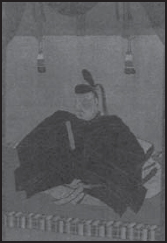
Tokugawa Ieyasu (1542–1616), lord of the Kantô plain (modern-day Tokyo and environs), was a descendant of the great Minamoto clan. The Minamoto gave Japan such luminaries as Yoshitsune, Yoritomo and Yoshiie. They became the only family from which the shôgun could come. The Minamoto themselves were long gone by 1600, but many branch families existed, and the Tokugawa were pre-eminent among them.
Ieyasu was the wealthiest daimyô in Japan. He ruled all eight provinces making up the Kantô, Japan’s ‘breadbasket’; domains that yielded him a total of 2.5 million koku, more than twice that of his nearest rival. With this wealth came influence and power. His armies were the largest, his men the best trained, his friends the most loyal. As a member of the tairô, Ieyasu also had a veneer of authority as a legacy from the late taikô.

Tokugawa Ieyasu (1542-1616) may have been the best general and strategist in Japanese history. At the very least, he was incredibly gifted, and almost always seemed to be in the right place at the right time. He was also phenomenally wealthy and powerful, and able to command great loyalty from friends and vassals alike. (Katô Kiyomasa/ Toyotomi Hideyoshi Museum)
When Hideyoshi had ordered the Korean invasion, the Kyûshu and Shikoku daimyô had borne the brunt of the cost in men and matériel, and Ieyasu, safe in the Kantô, had been shrewd enough to avoid any direct involvement in the campaign; while many of his enemies (and allies) had gone to fight, he had remained completely untouched by the conflict, his armies intact and in Japan.
He had missed several opportunities to gain dominance over the nation, dating back to Nobunaga’s assassination. Having been caught in the wrong place when Nobunaga was killed, he had valiantly risked his life racing across the country through hostile territory to attempt to avenge Nobunaga; but Hideyoshi was already there, so it was he, not Ieyasu, who was able to gain the popular support as the man who had put down the dastardly assassin Akechi Mitsuhide.
Always patient, he had bided his time; his chance would come. There is an old story that has Nobunaga as the man kneading the rice cakes, Hideyoshi as the man cooking them, and Ieyasu as the man who gets to eat them in the end.
It is an apt analogy. Nobunaga had never conquered all of Japan, but he might have. He definitely set the stage for Hideyoshi to come in and finish subduing the nation. Under Hideyoshi, however, there were still egos – powerful, hostile, well-armed egos – at work. It was up to Ieyasu to bring them all under his control and restore order. The bakufu (the shôgunal government) had been non-existent for nearly 30 years, and few were alive who remembered it when it had been fully functional, still decades earlier. Ieyasu saw it as his destiny – as a son of the Minamoto – to restore the bakufu.
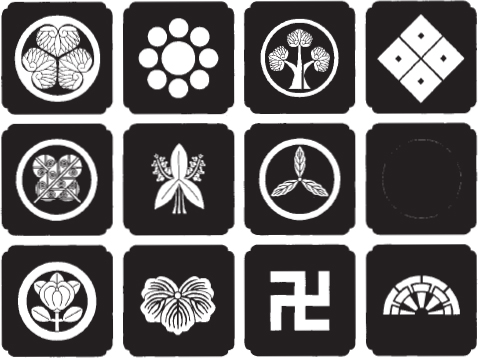
In contrast to the Western Army, the Eastern Army had more commanders of name who were unswervingly loyal to their cause. The crests of some of those commanders are shown here. Top row, left to right: Tokugawa, Hosokawa, Honda, Kyôgoku. Middle row: Ikeda, Fukushima, Yamanouchi, Kuroda. Bottom row: Ii, Tôdô, Hachisuka, Ikoma.
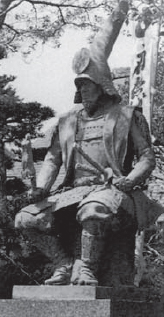
Katô Kiyomasa (1562-1611) was in Kyûshu during the campaign, fighting partly on Ieyasu’s behalf and partly on his own. His ferocity in Hideyoshi’s Korean campaigns had earned him the title ‘Kisho-kan’ or ‘devil general.’ Though a Toyotomi loyalist at heart, Kiyomasa fought on the side of Ieyasu for several reasons, not the least of which was his great hatred of Ishida Mitsunari. Ieyasu is commonly believed to have had a hand in Kiyomasa’s death years later, fearing that the latter might back Hideyoshi’s heir. (Katô Shrine, Nakamura Park, Nagoya)
He was a veteran commander, 58 years of age, with perhaps as many as 50 battles under his belt. He had been able to make alliances through diplomacy and marriage with many of the more powerful daimyô, and the time was right for action.
Fighting under the banner of Tokugawa Ieyasu were many experienced battlelords.
Katô Kiyomasa (1562–1611), aged 38, was a valiant general who had earned a name for himself in the Korean campaign. As a close friend of Hideyoshi (indeed, they had been born a few hundred yards – though several years – apart, and their mothers were supposedly related), Kiyomasa owed a great deal to the taikô’s favour. It was a shock to his friends when he came out for Ieyasu against the Toyotomi loyalists. His allegiance was more a reflection of his hatred of Mitsunari who had more than once impugned and injured Kiyomasa’s honour in Korea.
Kiyomasa was a devout member of the Nichiren Buddhist sect (the only sect of Buddhism in Japan that can be called hostile to outsiders), and he hated Christians with a passion. That he shared the Kyûshu province of Higo with the Christian daimyô Konishi Yukinaga (each held half as his fief) galled him no end. During the Sekigahara campaign, Kiyomasa did not participate in the main battle; rather, he stayed in Kyûshu, where he helped put down uprisings of loyalist forces, notably in actions involving attacks on Yukinaga’s castles.
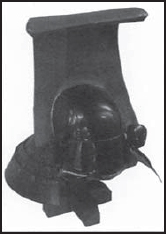
The simple three-plate zu-nari kabuto was often dressed up to make it more individualised. This variation is called an Ichi-no-Tani kabuto, and the sloping panel is intended to evoke the image of the cliff-face Minamoto no Yoshitsune led a charge down during the Genpei War (1180-1183). Both Ieyasu and Kuroda Nagamasa had helmets that were variants of this basic pattern. (Gifu Castle)
Katô Yoshiaki (1563–1631), no relation of Katô Kiyomasa, had also served in Korea, and was also originally a vassal of Hideyoshi’s. After the latter’s death, Yoshiaki had allied himself with Kiyomasa and Fukushima Masanori as the military force against Mitsunari and his political machine. His fief was a large part of Iyo, on northern Shikoku.

Ii Naomasa led a corps of warriors all clad in red lacquered armour. They came to be called ‘Ii’s Red Devils.’ This modern reproduction is of Naomasa’s own armour, a style called hishinui-dô, after the cross-lace ‘rivets’. The large horns were gilt. (Yoroi no Kôzan-dô)
Kuroda Nagamasa (1568–1623), aged 32, had also served in Korea, and before that in Kyûshu during the final stages of Hideyoshi’s unification of the nation. Nagamasa was a Christian, albeit a lukewarm one, and as a child had been baptised with the name Damian.
One of the most recognisable units in the campaign was the 3,600-man contingent of Ii Naomasa (1561–1602). Naomasa, aged 40, understood the value of psychology, and so had every one of his samurai wear red-lacquered armour, regardless of the actual type. So ferocious did they appear – and perform, it would seem – that they were nicknamed ‘Ii no akazonae’, or ‘Ii’s Red Devils’. His fief, held from Ieyasu, was Takasaki.
Ishida Mitsunari (1560–1600), the de facto commander-in-chief of the loyalist forces, was descended from the Fujiwara, an ancient aristocratic family that had once controlled the empire’s civil government. He was, however, a poor relation, and could boast neither the influence nor wealth of Ieyasu.
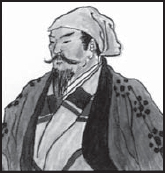
Ishida Mitsunari (1560-1600) was an able administrator, but he lacked foresight. His greatest skill was intrigue, but his personality defects undermined the success of this intrigue in the long run. His brusque manner had also created many enemies for him, many of whom chose to fight on the side of the East not out of great loyalty for Ieyasu, but out of a desire to wreak vengeance on a man many considered a civilian interloper. From a contemporary portrait.
He was one of the five bugyô, or administrators, named by Hideyoshi in 1585 to govern Kyôto (the other four were Maeda Munehisa, Natsuka Masaie, Asano Nagamasa and Mashita Nagamori), a position in which he seems to have performed well.
Mitsunari was devoted to Hideyoshi – some would use the term ‘lap-dog’ – and, after the death of the latter, to his son Hideyori. At least, he appeared to be devoted to Hideyori. Allegations have been levelled from time to time – and they carry considerable weight – that Mitsunari’s real motives were less than honourable. Whether his intent was honestly to secure Hideyori’s right to rule, or merely to advance his own position, we may never know.
Regardless of his motives, Mitsunari was an inveterate schemer; and what he couldn’t accomplish through diplomacy he was more than willing to accomplish by less acceptable means. At least once he tried to have Ieyasu assassinated, and his ruthless rounding up of hostages led to the brutal death of Hosokawa Gracia, wife of one of Ieyasu’s generals.
Oddly, Mitsunari owed his position and rank not so much to his martial prowess or family ties as to his skills at preparing and serving tea. The tea ceremony was a major cult in the military aristocracy, and the taiko had enthusiastically endorsed it and encouraged its growth. Hideyoshi was supposedly so taken by Mitsunari’s precision and artistry with the ceremony that he immediately adopted him into his inner circle, where Mitsunari displayed his administrative gifts and rose to be (arguably) the pre-eminent figure in the great unifier’s administrative staff.
His personal fief, held from Hideyoshi, was the province of Ômi, in the centre of the waist of Honshû. His seat was Sawayama Castle, which was strategically sited on the Nakasendô, a great trunk road running through the heart of Honshû, and played a major part in the battle’s main conflict.
Mitsunari had served with no special distinction in the Korean campaign as a member of Ukita Hideie’s staff. He was considered by many, even on his own side – to be no great warrior or general. Kiyomasa had more than once referred to him as a civilian butting into military affairs. He had fought, and he could command troops, but ultimately his gifts were not those of a strategist or tactician; even Hideyoshi had appointed him inspector general, giving him a staff position rather than a direct command of his own.



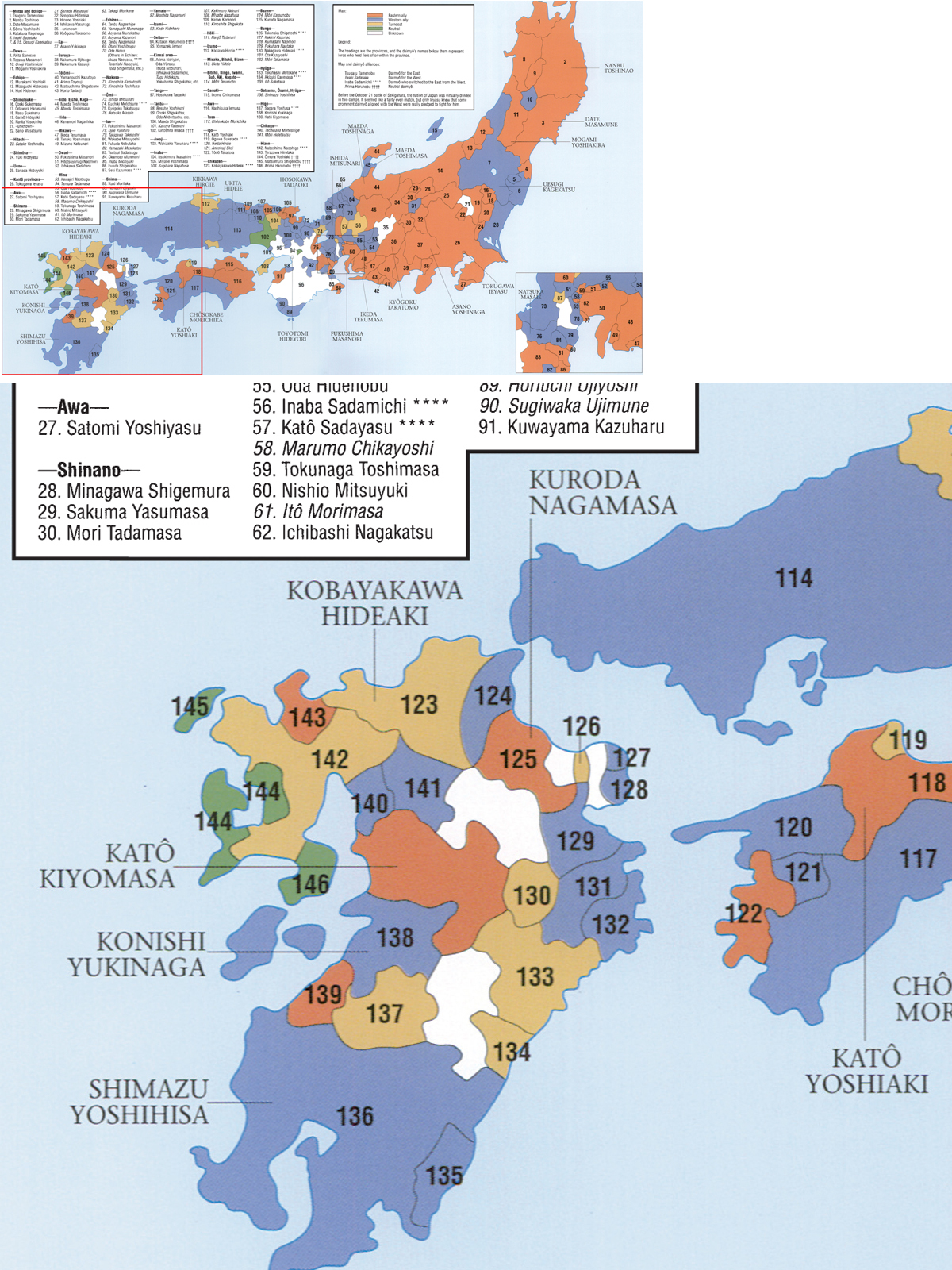

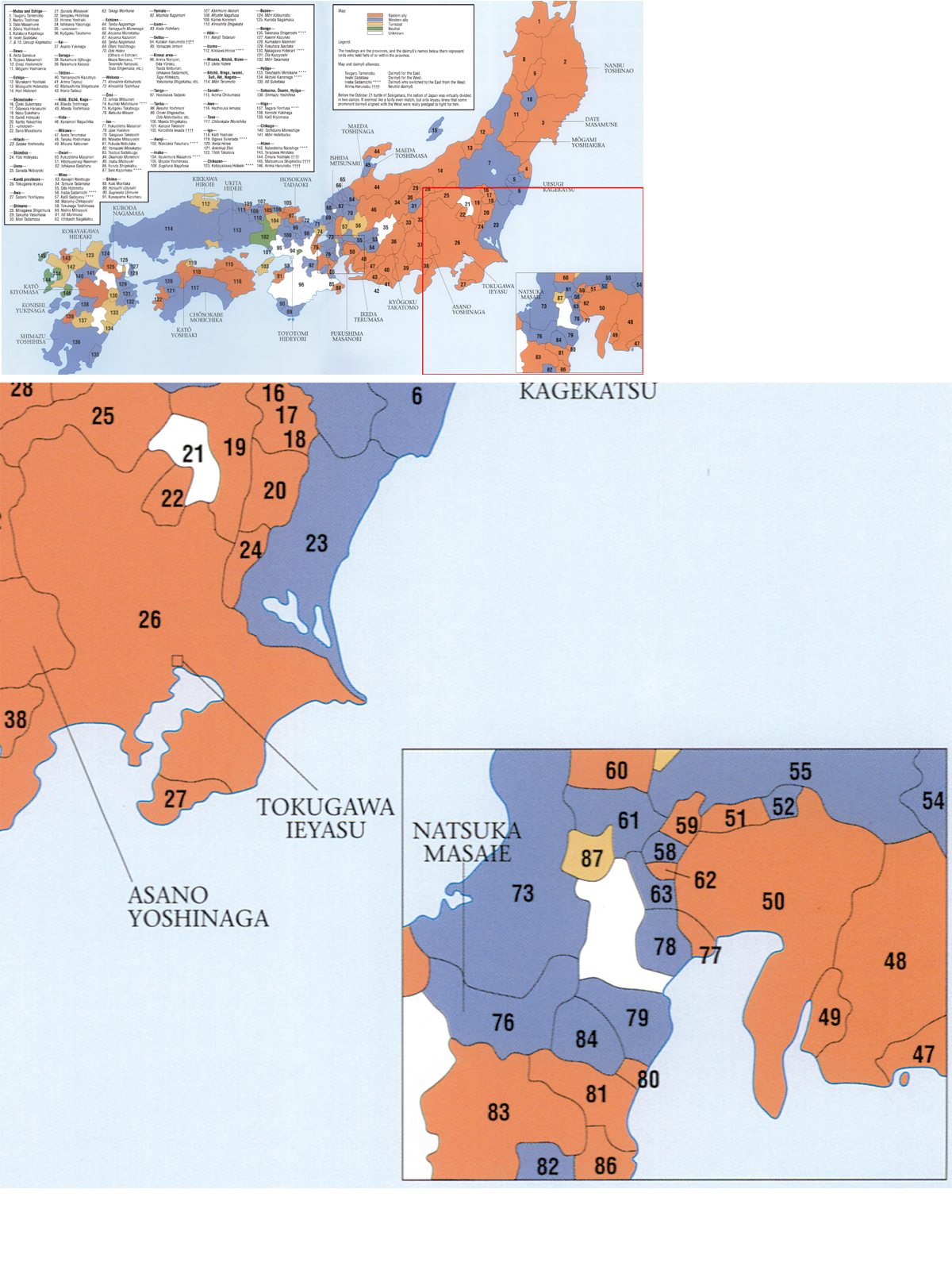
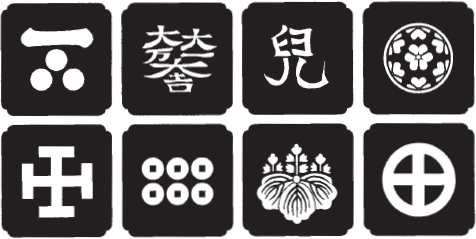
This graphic shows the mon or heraldic crests of some of the clans involved in the battle, fighting under the Western banner. Top row, left to right: Môri, Ishida, Ukita, Chôsokabe. Bottom row: Konishi, Sanada, Toyotomi, Shimazu.
Môri Terumoto (1553–1625), seven years Mitsunari’s senior, was the nominal commander-in-chief of the Western Army. The Môri clan was ancient and powerful, and they had far more men and matériel at their disposal than had Mitsunari. With Maeda Toshiie dead and his legacy spread among his heirs, Terumoto had become one of the most wealthy daimyô alive. The respective financial power of Ieyasu and Terumoto can be clearly understood through a popular saying that Ieyasu could make a road of rice from the Kantô plain to Kyôto, and Terumoto could make a bridge of silver and gold from his domains to the capital.
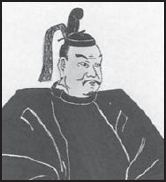
Môri Terumoto (1553-1625) was the powerful and wealthy head of the mighty Môri clan. Though made nominal commander-in-chief by Mitsunari, Terumoto was forbidden to actually take part in the battle. As revenge for this slight, his clan’s soldiers, one of the largest single contingents, would not move when ordered to attack. Afterwards, he would try to reconcile with Ieyasu, but the latter considered him a traitor unworthy of consideration. (From a contemporary portrait.)
Terumoto was worried about the potential loss of his provinces or even his life should he make the wrong choice and back the loser. His personal holdings were calculated at 1.2 million koku yearly, so this was no small concern. As he saw it, the victory in the coming struggle could go either way. He was leaning toward Ieyasu’s position until Ankokuji Ekei, one of Terumoto’s chief counsellors and a strong proponent of Hideyori’s cause, convinced him to back Mitsunari. Ekei had also convinced Kikkawa Hiroie, Terumoto’s cousin (and therefore another Môri Clan daimyô) to side with Mitsunari.
Mitsunari had been responsible for forming the anti-Tokugawa alliance, but the Môri name and reputation was greater than his, and Terumoto was one of the five tairô officially responsible for the welfare of Hideyori and the late taikô’s empire, so when Terumoto signed on, fellow daimyô Otani Yoshitsugu advised Mitsunari to step aside – at least publicly – and let Terumoto be made commander-in-chief. Mitsunari agreed to this, placing Ukita Hideie, another of the five tairô, as Terumoto’s second-in-command.
Mitsunari’s pay for stepping aside, however, was that he would continue to be the real commander, pulling all the strings, and that Terumoto would have to remain in Ôsaka Castle. This was the headquarters of the Toyotomi faction, as it had been the taikô’s seat of power. This arrangement while installing Terumoto as nominal head of the faction, guaranteed that he would have little or no influence over how the campaign would be waged or the battles fought.
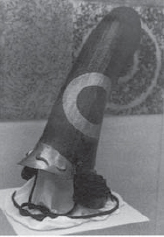
Katô Kiyomasa had several types of helmet during his career, but at least two were of this nagaeboshi-nari, which has become his trademark. There were at least half a dozen helmets based on various positions and styles of court cap; Kiyomasa’s was perhaps the most outlandish – and certainly one of the most recognisable. (Katô Kiyomasa/Toyotomi Hideyoshi Museum)
Unfortunately for the Western Army, Terumoto was an excellent commander, and Mitsunari was only second-rate on a good day. The assignment didn’t sit well with all members of the Môri clan. Kikkawa Hiroie was one of these, and it was he who convinced Terumoto that the best course of action was, in fact, no action at all.
Ukita Hideie (1572-1662) was the nominal second in command. He had been raised by Toyotomi Hideyoshi, and was understandably intensely loyal to the Toyotomi cause. During the Korean Campaign, the taikô had named him general-in-chief (gensui), and he performed admirably. He was one of the five regents (tairô) responsible for governing in Hideyori’s name. He ruled the rich provinces of Bizen and Mimasaka, and most of Bitchû, making him quite wealthy. On 21 October he favoured a night assault on the Tokugawa forces, and advised Mitsunari that striking while the Tokugawa were still deploying their forces in the foul weather would be certain victory. Mitsunari demurred, however, preferring a clear target he could see. Hideie was 28 years old.
Konishi Yukinaga (1560–1600) was one of the most powerful Christian daimyô. He had shared command of the vanguard of the first Korean invasion (1592) with fiercely anti-Christian Katô Kiyomasa; as unlikely and potentially explosive a combination as any that could have been made. Yukinaga had performed admirably, even forcing the Korean royal family to flee the capital; yet for some reason he and Mitsunari seem to have been lumped together as civilian administrators rather than military officers. His whole career seemed to involve sharing with Kiyomasa, even to the extent of their fief, for each man had half of the province of Higa on Kyûshu. The dislike was deep and mutual. Along with Shimazu Yoshihiro, he would bring up the rearguard. He was 39 years old in 1600.
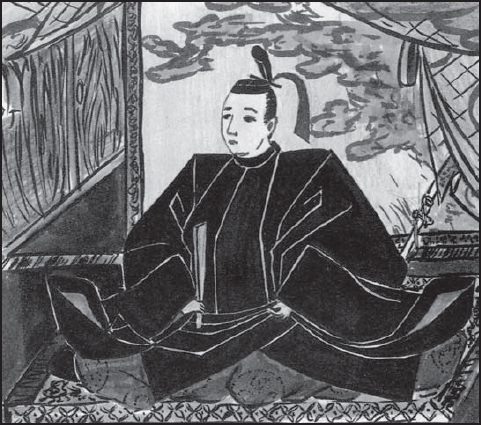
Kobayakawa Hideaki (1582-1602) was a nephew and foster son of the late Hideyoshi, but he bore no great love for Ishida Mitsunari, the protector of Hideyoshi’s son (Hideaki’s foster brother). Despite the offer of high office in return for his services, he would enter the battle on the side of Ieyasu, to the cries of ‘treason!’ His foster mother, Hideyoshi’s own widow, advised him to follow his conscience – and Ieyasu. He was only 19, and he turned the tide of battle. (From a contemporary portrait.)
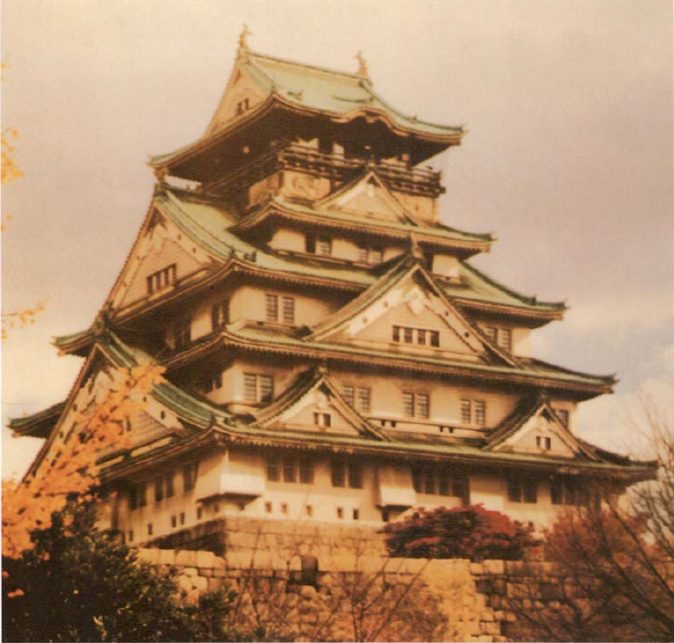
Ôsaka Castle was the seat of Toyotomi authority. Here resided Hideyori, the late taikô’s heir, and it was here too that Môri Terumoto was placed as ‘commander’ of the Western Army. This modern reconstruction follows the pattern of the Toyotomi structure.
Several major daimyô in the Western Army switched sides or failed to attack during the battle, assuring a Tokugawa victory. It is safe to say that the pivotal rôle in these defections was played by Kobayakawa Hideaki (1582-1602). Had he not betrayed Mitsunari, the Eastern Army may well have been destroyed entirely.

Several clans on the loyalist side defected outright or effected neutrality at the last moment by holding their positions and failing to engage the Eastern army when ordered to do so. The crests of some of them are depicted here. From left to right: Kobayakawa, Kikkawa, Wakizaka, Ogawa.
Hideaki was a young man at Sekigahara, just 19 years old. It is fascinating to reflect that with all the cumulative years of experience spread out among the commanders of both sides, the tide of battle was decided by the emotional ties of one young man.
Hideaki was, in fact, the nephew of Hideyoshi’s wife Ne-Ne, and had also been adopted as a foster son by the taikô. He had grown up in the care of Kuroda Yoshitaka. (Yoshitaka, baptised a Christian and named Simeon, was the father of another famous Christian general, Kuroda Nagamasa.) In addition to being both the nephew and foster son of Hideyoshi, he was a grandson of the great Môri Motonari, and therefore yet another cousin of Môri Terumoto. The convoluted interpersonal relationships of these great lords was the result of giving children in marriage to seal alliances; only occasionally did it actually result in the desired effect of assuring peace.
Hideaki’s relationships with Ieyasu and Mitsunari went back to the deceased taikô’s attempt to conquer Korea. On the basis of his ties with Hideyoshi, the 15-year-old Hideaki had been made commander of the army in 1597, with Kuroda Yoshitaka as his advisor. When the generals under Hideaki quarrelled and thereby brought about the failure of the campaign, one of their number, Ishida Mitsunari, had denounced Hideaki as an incompetent, and the taikô had ordered the latter to resign and return home in disgrace. In Japan, Ieyasu had intervened on Hideaki’s behalf, and reconciled Hideyoshi and his foster son.
It is safe to say that Hideaki never forgot the slight by Mitsunari, and never forgot the favour he owed to Ieyasu. In fact, Hideaki was on his way to join Ieyasu when the war council was called in Ôsaka, and Mitsunari himself talked Hideaki into joining the loyalist cause.
Mitsunari promised to make the young general the new kanpaku in return for joining the loyalist cause, and place Hideyori, his foster brother, in his care. (One can only assume that Hideyori would then take the title taikô.) It was a great offer, and one by which the young lord must have been sorely tempted. For his part, Ieyasu promised to reward Hideaki with two substantial domains for his allegiance.
Hideaki even went to his adoptive mother, Hideyoshi’s widow, to ask her what to do. Surprisingly, she told him to follow his conscience – and then suggested that his conscience should lead him to Ieyasu.
The question Hideaki faced as he began to march, under the banners of the Western Army, was which of the two men he trusted more – or less. As a child he had been very bright, and everyone had remarked on his mental acuity. Now he was faced with the most difficult – and dangerous – decision of his life.